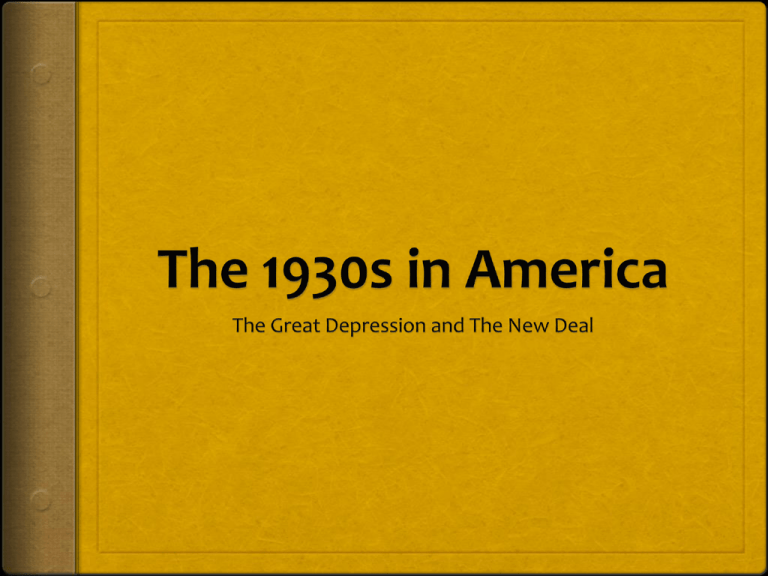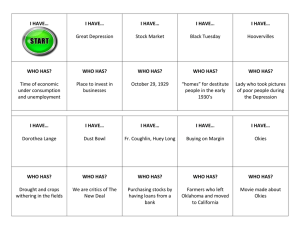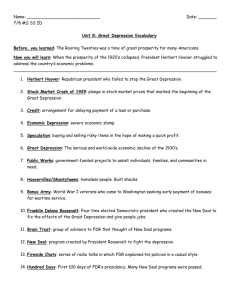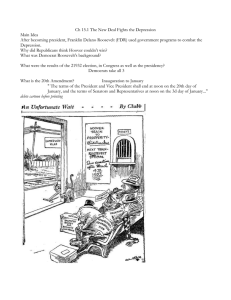
Recap – Buying on Credit
• Buy now, pay later
• Businesses give easy credit; consumers
pile up large debts
• Consumers have trouble paying off debt,
cut back on spending
The Stock Market
1920: stock prices rise steadily; people rush to
buy stocks, bonds
Many engage in speculation = buy on the chance
of making a quick profit
Buying on margin: pay small % of price, borrow
rest
Investing in Stock
Profit = $500
© 1998 by McDougal Littell Inc. All rights reserved.
Amount
borrowed
from broker
= $900
Amount
owed to
broker
= $900
Amount Paid = $100
Amount Paid = $100
Amount Paid = $100
Sold for $1,500
Sold for $500
BUYING STOCK
SELLING STOCK
Amount owed to broker = $900
Loss = $500
The Stock Market Crashes
October 29, 1929 (Black
Tuesday)
• Shareholders sell
frantically; millions of
shares have no buyers
• People who bought on
credit left with huge debts
• Others lose most of their
savings
The Great Depression
Great Depression: economy plummets,
unemployment skyrockets
1929–1940
Factors leading to Great Depression:
tariffs, war debts, farm problems, easy credit,
income gap
Bank and Business Failures
People panic, withdraw $$ from banks
Banks that invested in stocks fail;
people lose $
1929-1932: gross national product cut
nearly in ½
90,000 businesses go bankrupt
1933: 25% of workers jobless; those
with jobs have hours and pay cut
Worldwide Impact
Great Depression limits U.S.
ability to buy European goods
Hawley-Smoot Tariff Act:
highest protective tariff in U.S.
history
International trade drops;
unemployment soars around
world
Social Effects of the Depression
• People give up health
care, college, put off
marriage & children –
all cost $$
• 1928–1932: suicide rate
rises over 30%
• Admissions to state
mental hospitals triple
Hoover’s Economic Theories
• Many think depression is normal part of business cycle
• President Hoover says economy is still okay
• Gov’t should encourage cooperation between competing
groups
• People should take care of their own families, not depend
on gov’t
Hoover Tries Reassurance
Asks business, banking, and labor leaders to solve
problems
Creates organizations to help private charities raise
money for poor
“Boulder Dam” built on the Colorado River
Provides electricity, flood control, and water to states on
river basin … and provides JOBS
Later renamed Hoover Dam
Election of 1932
Democrats nominate NY Governor Franklin Delano
Roosevelt
FDR wins by overwhelming majority
The New Deal
New Deal: FDR’s plan for economic recovery and reform
The Hundred Days – passes over 15 New Deal laws in
first 100 days in Office
Example:
Emergency Banking Relief Act allows Treasury Dept. to
inspect banks
Decide which are failing, need loans, or are sound
Revives public confidence in banks
Fireside Chats
Gave “fireside” radio addresses explaining New Deal acts
Discusses need for public support of gov’t and banks
People feel a connection with President and gain faith in
New Deal
Regulating Banking and Finance
Glass-Steagall Act establishes Federal Deposit Insurance
Corporation (FDIC)
insures individual bank accounts, regulates banking practices
Federal Securities Act: companies must give all information
on stocks
Securities and Exchange Commission (SEC) created to
regulate stock market
Federal Housing Administration (FHA) gives loans for
mortgages, repairs
Adding to “Alphabet Soup”
Civilian Conservation Corps - public works jobs for
young men
Agricultural Adjustment Act (AAA) raises food
prices, lowers supply
Tennessee Valley Authority (TVA) creates jobs
renovating, building dams
Civil Works Administration - builds rural schools,
pays teachers
Opposition to the New Deal
Deficit spending: spending more $$ than gov’t
takes in
Funds New Deal
Policy still used today
Liberals: New Deal doesn’t do enough to help
poor, fix economy
Conservatives: New Deal used to control
business, socialize economy
The Second Hundred Days
• FDR launches second phase more relief for
farmers, workers
• 1936: FDR reelected, Democrats win large majorities in
both houses
• First time most African Americans vote Democratic
Improving Labor
1935: Social Security
Act creates Social
Security system
insurance for retirees 65
or older
unemployment
compensation
aid to disabled, families
with children
The New Deal Ends
1939: New Deal over (mainly for $$ reasons)
Supporters: FDR helped country recover from
economic difficulties
Conservatives: FDR made federal gov’t too large
Liberals: FDR didn’t do enough to end inequalities
Government’s New Role
FDR expanded power of president and federal gov’t
FDIC still protects investors; SEC still regulates
investments and monitors stock market
New Deal does not end Depression
Federal gov’t goes deeply into debt to create jobs and give
aid
Massive spending on equipment/supplies for WWII
ends Depression
Depression in Rural America
• 400,000 farms lost to foreclosure
Many become tenant farmers –rent land from someone
else
Farmers in Great Plains exhausted land through
overuse
Drought and windstorms hit make problem worse
Dust Bowl: area from North Dakota to Texas hardest
hit
Many families migrate to Pacific Coast states
The Black Blizzard
http://www.history.com/topics/dustbowl/videos#black-blizzard
FDR’s Fireside Chat on the Dust Bowl
http://www.history.com/speeches/fdrs-fireside-chaton-dust-bowl#fdrs-fireside-chat-on-dust-bowl






